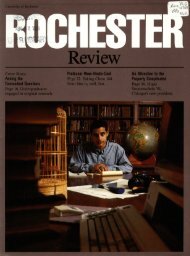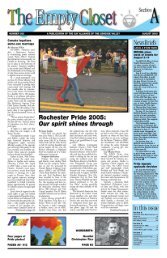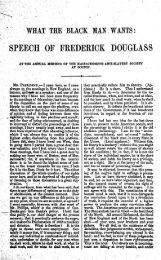Download PDF - University of Rochester Libraries
Download PDF - University of Rochester Libraries
Download PDF - University of Rochester Libraries
Create successful ePaper yourself
Turn your PDF publications into a flip-book with our unique Google optimized e-Paper software.
Computers have even poked their<br />
digits into the realm <strong>of</strong> that most<br />
"liberal" <strong>of</strong> liberal arts, music. At the<br />
Eastman School , for example, the electronic<br />
mu sic studio co nta ins a "dedicated"<br />
(i.e ., for music-studio use only)<br />
PDP-II , which assists in realizing,<br />
analyzin g, and, to some exten t, even<br />
composing musical scores.<br />
"Since the CPU will be running all<br />
night anyway ," say s R ob ert G ross' s<br />
introductory manual, " we might as<br />
well use it to make music. " A former<br />
doctoral cand ida te in compositio n who<br />
now head s a large com pu te r system at<br />
the Univer sity <strong>of</strong> California, Gross has<br />
written mu ch <strong>of</strong> the s<strong>of</strong>tware for the<br />
digital facility.<br />
" C ompos ing with a co mpu ter gives<br />
us a new element <strong>of</strong>con tro l," he says.<br />
" W e ourselves can construct the<br />
sounds, without using any in stru me n t<br />
but the com puter. " On the other hand,<br />
he adds, instrumental sounds can be<br />
very effectiv e in computer mu sic. " I n<br />
fact, mo st o f the pieces that come out<br />
<strong>of</strong> the Eastman stu dio begin with live<br />
performances or other familiar sounds<br />
tha t are then transformed by the co mputer."<br />
An example: Some com posers working<br />
in computer music experiment<br />
with the pr ecise "movement" <strong>of</strong><br />
sound , adding Doppler sh ifts that<br />
make the music seem to move and<br />
swirl around the concert hall. " You<br />
ca n ' t very well ask a string quartet,<br />
while it' s playing, to pick up its instruments<br />
and sidle aro und with<br />
them ," Gross remarks with a sm ile.<br />
" Rep resen ting sound , thou gh , is<br />
com plicated . You need about 40,000<br />
digital characters per second to do it.<br />
The Eastman system,w ith eightymegaby<br />
tes <strong>of</strong>added memory, ca n<br />
handle twelve minutes <strong>of</strong> continuous<br />
sound. Longer pieces a re spliced together<br />
from these sho rte r sections. "<br />
Currently the system supports abou t<br />
two dozen u sers: stud io director Allan<br />
Schindler, fellow p r<strong>of</strong>essors Alexander<br />
Brinkman and Robert Morris, a handful<br />
<strong>of</strong> advanced composition students,<br />
and a class in " Co mputer Applicati ons<br />
in Music ."<br />
"My recent work," says Brinkman,<br />
"has been setting up s<strong>of</strong>tware tools for<br />
musical analysis. " Brinkman's program<br />
"Score-l l , " for instance, helps<br />
make the comp uter more friendly to<br />
the com poser. It allows the user to<br />
enter no tes in a form th at is more like<br />
music than like machine language .<br />
" We're fin ally getting some real<br />
music out <strong>of</strong> the machine," Schindler<br />
exults. " It's close to where you won't<br />
put on a separate hat for compu ter<br />
music and say, ' H mm, that's interesting<br />
,' and then go to hear a symphony<br />
a nd say, 'Ah , that ' s beautiful.<br />
' "<br />
All composition majors at Eastman<br />
study computer or electro nic music<br />
techniques, or both . "It's part <strong>of</strong> the<br />
In stant reg istration: Students in the Graduate School <strong>of</strong> Management register by computer. "It's<br />
common en ou gh to enter reg istrations into a computer," says GSM's associate d ean Richard<br />
West, "but it is usually done by staff people after stu d en t s have m ade out all their forms. This wa y<br />
is qu ick and con venien t for everybody, and re cords are always up to the minute. " The co mputerized<br />
sy stem al so allows for phoning in a re gi stration from a home or <strong>of</strong>fice co mp u ter via<br />
telephon e lines.<br />
equ ipmen t you 're expected to have as<br />
a composer . The co mpu ter is a ba sic<br />
element <strong>of</strong> the technology <strong>of</strong>ou r age, "<br />
Schindler says, " a nd we're working to<br />
170 Data, <strong>University</strong>'s<br />
computer science department;<br />
founded 1974, devoted<br />
primarily to graduate<br />
education and to research;<br />
individual courses as well<br />
as an introductory course<br />
avai lable to undergradua<br />
t e s . Primary research<br />
areas: Artificial Intel-<br />
I igence, computer systems,<br />
and theory.<br />
pu t this technology at the service <strong>of</strong> the<br />
im agination and feelings <strong>of</strong> mu sicia<br />
ns ." It is com forting, nevertheless,<br />
upon leaving his <strong>of</strong>fice, to notice there<br />
is still room for his practice piano and<br />
met ronome in the corn er. The compu<br />
ter ca n cr eate new worlds <strong>of</strong> sound ,<br />
bu t most <strong>of</strong> these sounds have a<br />
familiar origin: a co mposer plinking<br />
out a few strands <strong>of</strong> melody at the<br />
plano.<br />
M eanwhile, back at the Ri ver C ampu<br />
s, the visual arts ha ve also begun to<br />
explo it computer technology. O ver the<br />
course <strong>of</strong> the last year, two "com pute r<br />
artists" from the U n iversity <strong>of</strong> Pari s,<br />
wh o were visiting at the electrical<br />
enginee ring department's Production<br />
Au tomation Project (PAP), created<br />
three-dimensional art using FOR<br />
TRAN and 3-D com pu ter-gra ph ics<br />
techniques. As Science News reported<br />
last fall , one <strong>of</strong> their ex perimen ts<br />
resulted in a model <strong>of</strong> a dinosaur based<br />
on measurements taken from a bal sa<br />
wood kit, its su rface deformed to<br />
sim ulate a furry coat. The hai ry hybrid<br />
wa sn 't beautiful, recalls PAP' s<br />
Arist ides Requicha, " bu t it was cu te ."<br />
U su ally, how ever , the Production<br />
Automation P roj ect , whi ch is directed<br />
by pr<strong>of</strong>essor Herbert Voelcker , is cited<br />
in national medi a for its involvement<br />
in more practical proje cts . Computer<br />
AidedEngineering in its February issue<br />
cited th e " strong influen ce" <strong>of</strong><br />
Voelcker and PAP on the direct ion <strong>of</strong><br />
the " most sophisticated U.S. solidmodelin<br />
g systems." Earlier, a popular<br />
magazine, in an article on the use <strong>of</strong><br />
compu ters in desi gning "everyt h ing<br />
from oil re fine ries to tennis shoes,"<br />
referred to <strong>Rochester</strong> as "the recognized<br />
lead er in Computer-Aided<br />
II

















